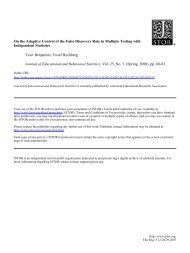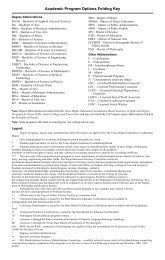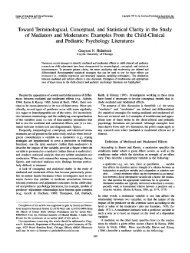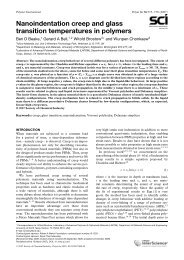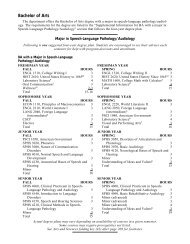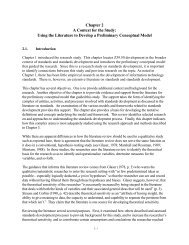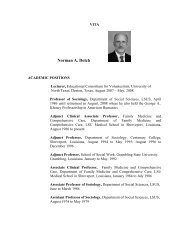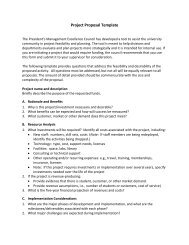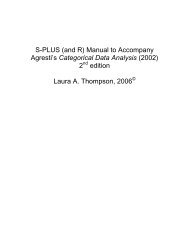APPENDIX C-4 Record Content Analysis Methodology
APPENDIX C-4 Record Content Analysis Methodology
APPENDIX C-4 Record Content Analysis Methodology
Create successful ePaper yourself
Turn your PDF publications into a flip-book with our unique Google optimized e-Paper software.
Moen & McClure An Evaluation of U.S. GILS Implementation June 30, 1997<strong>APPENDIX</strong> C-4<strong>Record</strong> <strong>Content</strong> <strong>Analysis</strong> <strong>Methodology</strong>
June 30, 1997 An Evaluation of U.S. GILS Implementation Moen & McClure
Moen & McClure An Evaluation of U.S. GILS Implementation June 30, 1997<strong>APPENDIX</strong> C-4<strong>Record</strong> <strong>Content</strong> <strong>Analysis</strong> <strong>Methodology</strong>Table of <strong>Content</strong>s1.0. Introduction............................................................................................................... ............................... 12.0. Method Overview............................................................................................................ ......................... 13.0. Objectives ................................................................................................................................................ 14.0. Context Within The Evaluation Framework............................................................................................. 25.0. Data Collection and <strong>Analysis</strong> ................................................................................................................... 25.1. Survey of GILS Universe................................................................................................................. 25.2. Development of <strong>Analysis</strong> Criteria.................................................................................................... 45.2.1. Issues in Developing <strong>Record</strong> <strong>Content</strong> Aggregation Criteria ................................................. 55.3. <strong>Content</strong> <strong>Analysis</strong> of Sampled <strong>Record</strong>s............................................................................................. 66.0. Method Limitations and Recommendations to Future Researchers.......................................................... 87.0. Conclusion................................................................................................................. ............................... 8Table C4-1 <strong>Record</strong> <strong>Content</strong> <strong>Analysis</strong> Sample Population.......................................................................... 3Table C4-2 <strong>Record</strong> <strong>Content</strong> <strong>Analysis</strong> Criteria............................................................................................ 4Table C4-3 Aggregation Semantics............................................................................................................ 6Table C4-4 Information Object Semantics................................................................................................. 7
June 30, 1997 An Evaluation of U.S. GILS Implementation Moen & McClure
Moen & McClure An Evaluation of U.S. GILS Implementation June 30, 19971.0. INTRODUCTION<strong>APPENDIX</strong> C-4RECORD CONTENT ANALYSIS METHODOLOGYMoen and McClure, in The Government Information Locator Service (GILS): Expanding Research andDevelopment on the ANSI/NISO Z39.50 Information Retrieval Standard: Final Report (1994, p. 30) noted “animportant factor in the overall utility of the GILS will be the quality of the data in GILS records. Quality criteria willinclude accuracy, consistency, completeness, and currency. In order to encourage the creation of high qualityinformation that will populate GILS servers, the development of written guidelines for creating GILS records isessential.” This direction, The government information locator service: Guidelines for the Preparation of GILSCore Entries (National Archives and <strong>Record</strong> Administration, 1995a) is available electronically from the NationalArchives gopher at under “Information for Archivists and <strong>Record</strong>s Managers/GILS Guidance,”or from . In addition, Federal information processing standardspublication 192, Application Profile for the Government Information Locator Service (GILS) (National Institute forStandards and Technology, 1994) provides other quality-related direction such as preferred order of display forrecord elements as well as their definitions.<strong>Content</strong> analysis of GILS records served three purposes: to assess records’ quality in terms of completeness andaccuracy; to explore the relationship of selected characteristics of records and serviceability in networkedinformation discovery and retrieval (NIDR); and to develop recommendations for future application or adaptation ofthe method.More than 3500 instances of metadata were evaluated for incidence and/or content, and entered into a database forcoding and analysis. In addition, the evaluators maintained a log of lessons learned and areas for further research(see Appendix E-2 <strong>Record</strong> <strong>Content</strong> <strong>Analysis</strong> Findings, Discussion, and Recommendations) that may be utilized bysystem developers, specification and procedures writers, and people with direct responsibility for GILS recordquality.2.0. METHOD OVERVIEWThe analysis comprised in two phases: Phase 1 involved examination of a pool of 83 records from 42 agencies’ GILSretrieved deliberately to represent a range of information resource types (e.g., databases, catalogs, records systems).These records served as the basis for developing and operationalizing a set of more than 50 qualitative andquantitative evaluative criteria that included records’ format, aggregation, media representation, and descriptiveness.Descriptiveness was defined as the incidence of utilization and content (value) attributes for all mandatory andselected optional elements and subelements as specified by FIPS Pub. 192 Annex E-GILS Core Elements and theNARA Guidelines. In Phase 2, these criteria were systematically applied to a set of 83 records randomly retrievedJanuary 13 and 14, 1997, from 42 agencies’ GILS.The following paragraphs present information concerning the record content analysis objectives, the context of theanalysis within the overall evaluation framework, data collection and analysis, method limitations, lessons learned,and recommendations.3.0. OBJECTIVESThis analysis attempted to describe the “quality” of GILS records in terms of character or attributes rather than strictconformance to specifications. The latter, which constitutes an audit, would require a greater level of operationaldetail than current policy and standards provide and is a technique better suited to a more mature informationservice. The following objectives guided the current examination of GILS records. Where adherence to publisheddirection was relevant, FIPS Pub. 192 Annex E definitions, as reproduced and supplemented by usage guidelinesand examples in the NARA Guidelines, served as the basis for evaluation:1. To assess the accuracy of GILS records in terms of errors in format and spelling2. To gauge and compare the relative “completeness” or level of description of GILS records- Number of elements per record (“blank” vs. populated)C-4—Page 1
June 30, 1997 An Evaluation of U.S. GILS Implementation Moen & McClure- Utilization and values of both mandatory and selected optional elements3. To characterize a general profile of GILS product in terms of record types, aggregation levels, andcontainers (dissemination media)4. To evaluate records’ serviceability- Factors affecting NIDR- User convenience- Aesthetics and readability- Relevance judgment.The quantitative and qualitative assessments, respectively, of the constitution and properties of sampled recordsprovided data meeting these objectives.4.0. CONTEXT WITHIN THE EVALUATION FRAMEWORKAs with the other methods comprising this user-oriented evaluation of GILS implementations, the record contentanalysis both was informed by and served to inform other data collection and instrument development activities inthe study. Presentations and panel discussions at the 1996 GILS Conference and focus groups with various usercommunities highlighted recurring issues surrounding the content of GILS records, such as the level of resourceaggregation, suitability of metadata elements, consistency, and quality of presentation. In turn, as discussed inAppendix E-2 <strong>Record</strong> <strong>Content</strong> <strong>Analysis</strong> Findings, Discussion, and Recommendations, the record content analysisproved invaluable in developing a user-assessment script that would both isolate GILS “quality” from that of the userinterface or search engine and present realistic information retrieval encounters.5.0. DATA COLLECTION AND ANALYSISData collection and analysis were performed as described in the following paragraphs using the tool presented inAppendix D-4 <strong>Record</strong> <strong>Content</strong> <strong>Analysis</strong> Instrument as constructed in a Microsoft Access© database and MicrosoftExcel© spreadsheets. Two surveying activities were prerequisite to the analysis of record content: a determinationof the GILS universe to optimize the breadth of the sample and a review of planned (i.e., per the NARA Guidelines)vs. actual record characteristics to inform development of analysis criteria.5.1. Survey of GILS UniverseTo provide the broadest possible base for record selection, the investigators first determined the universe of GILSimplementations. This was accomplished through various means:• Verbal or written mention during the 1996 GILS Conference presentations and in handouts and surveyresponses, respectively• Linking from the White House website’s “President’s Cabinet” and “Federal Agencies andCommissions” to agency homepages, which, in turn, linked in some cases to FedWorld GILS• WWW searches by means of Alta Vista and Lycos search engines for Executive department and agency names− As delineated in the 1996-97 Government Manual via the Government Printing Office (GPO) GPO−Access http://www.access.gpo.gov/su_docs/aces/aaces002.html>As comprising the Chief Information Officer Council as specified in Executive Order 13011 of July16, 1996 “Federal Information Technology”(http://www.gsa.gov/irms/ka/regs/exo13011/exo13011.htm)• WWW searches by means of Alta Vista and Lycos search engines for “GILS” and for “governmentinformation locator service”• GPO Access GILS server.Results of this effort, completed on December 31, 1996, are shown in below in Table C4-1 <strong>Record</strong> <strong>Content</strong> <strong>Analysis</strong>Sample Population with two additional agencies identified for sampling in Phase 2 of the record content analysis.C-4—Page 2
June 30, 1997 An Evaluation of U.S. GILS Implementation Moen & McClure5.2. Development of <strong>Analysis</strong> CriteriaThe second activity to prepare for a systematic analysis of GILS record content was the creation of criteria to satisfythe study objectives. This was accomplished by examining a set of two records retrieved from each identifiedagency GILS. These records—retrieved by use of search terms including “system,” “database,” “manual,” theagency acronym, subject-oriented single words—were selected to represent a variety of file sizes, formats, andcontent types.These records were studied and compared to produce the assessment categories shown in Table C4-2 <strong>Record</strong><strong>Content</strong> <strong>Analysis</strong> Criteria. (Appendix D-4 <strong>Record</strong> <strong>Content</strong> <strong>Analysis</strong> Instrument presents a table of the databasefields, possible values, and coding notes that was constructed to record data.)Accuracy• Format and Formatting Errors• Spelling And Typographical ErrorsTable C4-2<strong>Record</strong> <strong>Content</strong> <strong>Analysis</strong> CriteriaCompleteness• Number Of Elements Per <strong>Record</strong>• Practice Of Presenting “Blank” (Nonpopulated But Displayed) Elements• Utilization And Selected Characteristics Of “Mandatory” Elements− Title− Sources Of Data− Originator− Access Constraints− Local Subject Index− Use Constraints− Abstract− Point Of Contact− Purpose− Schedule Number− Agency Program− Control Identifier− Availability-Distributor− <strong>Record</strong> Source− Availability-Order Process− Date Of Last Modification• Utilization And Characteristics Of Selected “Optional” Elements− Controlled Vocabulary-Index− Local Subject IndexTerms-Controlled− Availability-Resource Description− Controlled Vocabulary-Thesaurus− <strong>Methodology</strong>Profile• <strong>Record</strong> Types (AIS, locator, Privacy Act system)• <strong>Record</strong> Aggregation (See Table C4-3 Aggregation Semantics and discussion)• Objects Represented (see Table C4-4 Information Object Semantics)• Containers (Dissemination Media)− Broadcast (Radio/TV)− Listserv− CD-ROM− Microform− Dialup− Multiple− Email− Print− Fax− Video− Ftp Site− Voice− Gopher Site− WebServiceability• Capitalization• Citation Of Legislation• Definition Of Acronyms• Element Display Order• Fielded-Search Option• File Formats• Hypertext• Indentation• Locally Defined ElementsC-4—Page 4
Moen & McClure An Evaluation of U.S. GILS Implementation June 30, 19975.2.1. Issues in Developing <strong>Record</strong> <strong>Content</strong> Aggregation CriteriaThe following definitions served as an initial starting point for operationalizing the phenomenon of aggregation:AGGREGATION: the degree to which two or more separate parts have been brought together withoutchanging their function or producing any result other than the sum of the operation of the parts.GRANULATION: the degree to which two or more separate parts of a whole are distinguishable within thatwhole.It became apparent during review of the Phase 1 sample that the above definitions are unsuitable for application toGILS records. For example, a record describing a publicly-accessible enterprise-wide AIS whose function is to trackinformation output of four discrete, functionally dedicated, not publicly accessible micro-AISs could be labeled a“highly aggregated” record in that it “rolls up” other potential records. But, should the record include a descriptionof each “grain” (microsystem) it embraces, one would be tempted to code it “low granularity” (subparts aredistinguishable).Another, more concrete, example of the problem of characterizing aggregation of information resources would beThe Federal Register in digital (databased) or paper print format. This one record describes one “discrete”publication, but that publication aggregates myriad standalone information objects that, in print, are highly granularto the initiated user but in database form (digital format) are less distinguishable.Another, more concrete, example of the problem of characterizing aggregation of information resources would beThe Federal Register in digital (databased) or paper print format. This one record describes one “discrete”publication, but that publication aggregates myriad standalone information objects that, in print, are highly granularto the initiated user but in database form (digital format) are less distinguishable.In short, the attribute of “aggregation” is discernible only to the degree that the GILS record presents an explicitenumeration of “granules” or aggregated parts—whether those parts are:• book chapters,• database fields,• Web page titles, or• Privacy Act records,which some will argue is too granular, or they are:• individual reporting systems of enterprise-wide AIS,• titles within a videotape series, or• memoranda within a “file,”which some will argue should be distinguishable.Application of definitions of aggregation and granularity imply a knowledge of component-level and collectivefunctionalities that the investigators, and, by proxy, a GILS user, lack and which may be gained only throughexamination of the object. In a physical library, users of a card catalog, subject bibliography, or other metadatabasedtools are accustomed to retrieving and scanning resources’ object-peculiar “primary” metadata (e.g., tables ofcontent, graphics, and back-of-the-book indexes) as required to determine whether “granules” might satisfy theirinformation need; in GILS, where often information resources cannot be examined and thus their “operation” isunknown, the concept of simply “pointing” to an aggregated “locator” may be insufficient in that the aggregation“produces no result other than the sum of the operation of the parts.”Nonetheless, because record and resource aggregation was identified as a recurring theme during other datacollection activities of the study, investigator’s adopted the operational definitions of aggregation coding schemeshown in Table C4-3 Aggregation Semantics to characterize the phenomenon. To supplement the limited valuereturned from assigning aggregation-level coding, investigators incorporated the criterion of “information object” asdefined in Table C4-4 as well. Appendix E-2 <strong>Record</strong> <strong>Content</strong> <strong>Analysis</strong> Findings, Discussion, and Recommendationsoffers additional interpretation of the utility of these measures relative to aggregation and resource description.C-4—Page 5
June 30, 1997 An Evaluation of U.S. GILS Implementation Moen & McClureTable C4-3Aggregation SemanticsCode Operational Definition Examples<strong>Record</strong> AggregatesObjectsGILS record, by virtue of its creation, collects discreteinformation resources that record content indicateswould not have otherwise been collected or aggregated.• Privacy ActSystemscompilationAssigned in the absence of clues within the record that • filesthe represented objects were heretofore packaged as • press releasesthis collection to optimize information discovery andretrieval.• formsAggregated ObjectRepresentedDiscrete ObjectRepresentedObject AggregatesMetadataGILS record represents an a priori or purposefulcollection of information resources—e.g., woodpeckerdatabase or agency website. GILS record represents anobject that collects, or comprises, two or more discreteinformation objects, and that represents a collection ofstandalone information files or products packagedtogether on the basis of a common theme or subject forfunctional convenience.GILS record describes a standalone document-levelentity that does not meet the criteria for “objectaggregates metadata” below.GILS record describes a pre-existing metadatacollection, or “locator,” as an information resource.• CD-ROM ofregulations• System thatcompiles PrivacyAct records• job line of openrequisitions• annual report• videotape• directory• catalog• index• log5.3. <strong>Content</strong> <strong>Analysis</strong> of Sampled <strong>Record</strong>sAs of early January 1997, 42 agencies’ GILS had been discovered by procedures identified in Section 5.2 Survey ofthe GILS Universe. The 83 sampled records, selected as described in the next paragraph, resided in three broad“host” categories: GPO (61% of the sample), record sources (34%), and FedWorld (5%). 93% of sampled recordsresided on a WAIS or Z39.50-compliant server, with the remaining on an HTTP server containing standalone HTMLfiles of GILS records. (Note: since the time period of analysis, FedWorld and GPO have mounted record-sourcehosted GILS and those hosted by one another, and at least one HTTP-based GILS has migrated to WAIS).The record content analysis per se first involved selection of GILS records from the known GILS universe (seeTable C4-1 <strong>Record</strong> <strong>Content</strong> <strong>Analysis</strong> Sample Population) in one of two ways. For GILS featuring a search engine(i.e., residing on an information retrieval-based platform such as WAIS or Z39.50-compliant server or including asite-resident search engine), the investigator retrieved the first and last “hits” resulting from a “full-text” query of theagency acronym (using the default “number of records to return”). For GILS on which this was not possible (i.e.,those mounted on a web server of HTML files that present only a picklist of record titles as if for known-itemretrieval or browsing), the investigator retrieved the first and last items listed. In the event of multiple record formatsper record, the HTML format was selected.The resultant 83 records (one agency’s GILS featured only 1 record) were printed for ease of study and comparativereference. Their characteristics were assessed and recorded in a relational database for compilation andsubsequently transferred to a spreadsheet for analysis using descriptive statistics. A subset of the total was createdand subject to identical analysis by filtering the data for values of “US Federal GILS” or “U.S. Federal GILS” in theControlled Vocabulary-Local Subject Index-Local Subject Term subelement—a state presumed to indicate recordcreators’intention of identifying the record as a “Core record” as delineated in the NARA Guidelines. No furtheroperationalization of the “Federal Core” was achieved in this evaluation. The “Core subset” comprised 50% of thetotal sample.C-4—Page 6
Moen & McClure An Evaluation of U.S. GILS Implementation June 30, 1997Table C4-4Information Object SemanticsObject Operational Definition ExamplesAdministrativeCatalogAgencyHomepageBibliographicDatabaseFormJob LineMiscellaneousDocuments InAd HocCollectionOrganizationProgramPublicationPublicationsCatalogSubject MatterDatabaseSystem OfSystemsA locator listing of procedural actions related tothe conduct of agency businessInformation mounted on an HTTP serverAn automated information system comprisingmetadata about bibliographicentities/publicationsA document designed to elicit and transmitspecific information from the user to thesupplier, respectivelyA telephonic recording of employmentopportunitiesPlurality of documents grouped by function orsubjectA set of human resources defined by an agencyto provide specific products or servicesA prescribed set of activities and functionsperformed to accomplish an objectiveDiscrete monographic document published onetimeor in serial mode to disseminateinformationA fixed, flat (non-machine-searchable) listing ofselected or all agency publicationsSingle, stand-alone automated informationsystem comprising data, records, or multipledocuments on technical or administrativesubject(s) and/or definable reference themesMacro-AIS comprising or integrating multipledatabases and/or single-AISsFERC’s “Directory Of ExternalInformation CollectionRequirements”PBGC’s “Log Of BenefitTermination Plans”USPS’s “Index Of FinalOpinions And Orders”“Superintendent of DocumentsHome Page on the WorldWide Web”DOE’s “OpenNet”“HUD USER”“Request for Registration forPolitical Risk Insurance“SSA-1710”“DOI Employment Center”bulletins and memorandapress releasespublic commentsunder-described “technicaldocuments” and “reports”update noticeslettersspeechesrecordsinformation center/libraryresearch consortiumNASA’s “Flight DynamicsFacility”report managementrecords managementannual reportuser’s manual“The Federal Register”Regulations CD-ROMfact-sheet seriesprocedures manualFEMA’s “PublicationsCatalog”Privacy-Act recordshealth risksaviation accidentsred cockaded woodpeckerDOD’s “Enterprise InformationSystem”EPA’s “Information SystemsInventory”C-4—Page 7
June 30, 1997 An Evaluation of U.S. GILS Implementation Moen & McClure6.0. METHOD LIMITATIONS AND RECOMMENDATIONS TO FUTURE RESEARCHERSThe primary limitation to the procedures described for analyzing GILS record content is generalizability—the extentto which results can be assumed valid for the entire population of GILS records. The sample was small, less than 2%of the estimated total of approximately 5,000, and the sampling technique was largely convenience-driven due totime constraints. In addition, the method as employed did not provide data concerning differences in record qualityamong or within agencies’ GILS, which might prove useful in estimating the scope of effort required in modifyingelements or standardizing the characteristics of element values.The record content analysis was extremely time-consuming, both in terms of defining mutually exclusive codes forcontent description and data collection. As noted above, even this small sample involved recognition of presence orabsence of thousands of instances of metadata elements as well as examination and description of their values. Muchof the labor burden of the current procedure could be alleviated by machine processing—e.g., for element counts,incidence of hypertext, etc. In addition, it is anticipated that the exploratory method described herein will be refinedand adapted during subsequent applications, both for assessing the responsiveness of government-wide qualitystandards for GILS (vis a vis the NARA Guidelines) and, at the agency level, the quality of GILS record collections.7.0. CONCLUSIONIn summary, the method employed to analyze the content of GILS records proved highly satisfactory in rendering thetype of results that would inform the overall evaluation. By providing a bird’s-eye view of the “product on the shelf”at a given point in time, this method allows a comparison of planned vs. actual outcomes for quality. Agencies’continuous analysis and reporting of record content will serve well in complementing evaluations of the effectivenessof the NARA Guidelines, implementation maturity, and user satisfaction.C-4—Page 8



